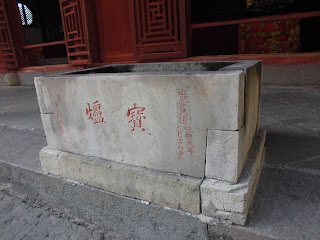今日も長崎についてポストしたいと思う。今回は
崇福寺を紹介する。でもその前に鳥の写真を貼っときたい:
I'm making one last post about Nagasaki today. This time I want to introduce Soufukuji, a Buddhist temple with a lot of visible, obvious Chinese influence. But first birds:
在長崎有三座「福寺」。是「興福寺」,「福濟寺」,和「
崇福寺」。這三座都不但名字抱括「福」字,也受到中國的影響。最簡懂的就是崇福寺。正門亮紅,一看就知道是中國方式的。今天我想要介紹這座廟,但是我想先介紹一隻鳥:
また、この中華式仏:
And Chinese-looking Buddhas:
還有一個華式的佛像:
では、崇福寺。このお寺は福済寺と興福寺と並んで、長崎三つの福の一つだ。三つとも名前に「福」が入っているだけじゃなく、中国との繋がりがある。崇福寺は中に一番わかりやすいと思う。特に明朝式の赤い正門が中華っぽい。
Soufukuji is one of the "Three Fuku" temples in Nagasaki. As funny as that looks in English, "fuku" is the Japanese reading of the Chinese character for "luck"(福). (And "luck" rhymes with...Nah. I won't go there.) The other two are
Koufukuji and
Fukusaiji.
These three temples all have "fuku" in their names and all have a great degree of Chinese influence. Soufukuji is the most obvious of the three thanks to its bright, red entrance gate built in a southern Ming style.
好吧,接下來這就是正門。好厲害吧!
めっちゃ中国っぽい
Bam! China!
沒錯,華式!
Nothing about this really even looks Japanese to my eye. Not that I'm an expert or anything, but I never let that stop me from making bold, statements.
完全沒有日本的味道。
門を通り抜けてから階段を登る。
After passing through the gate there are some stairs up to the temple itself.
通過正門就開始爬樓。
階段の上の「第一峰門」
Here's the next gate.
下一座門
上から見た正門
The first gate again.
在樓梯上看正門。
These stylized bats are just like the ones you can see on Chinese-style architecture. "Bat" in Chinese is almost kinda sorta a homophone for "luck", so bat designs are used a lot on temples and whatnot.
蝙蝠也會造成華式的氣氛。
コウモリ(蝙蝠)は中国語では、二文字目の発音が「福」と同じだから、コウモリのデザインが中華式の寺廟によく出てくる。
After passing through the second gate, we approach the main buildings.
Lots of red everywhere. Aside from Inari Shrines, Japanese religious buildings don't usually make quite as heavy use of red as Chinese religious buildings do.
日本的寺廟平常不會這麼利用紅色。尤其是神社常常只是用無忝的木頭來建的。
福建に人気ある媽祖様の偶像
The goddess, Mazu
媽祖!
以前の飢饉に使われた臼。これで飯を作って餓死している人達を救った。
A kettle that was built to feed the starving, well-washed (they
were Japanese after all) masses during some famine or other.
以前有飢荒的時代,寺廟利用這個釜煮飯,給人吃。
日付は「中華民国」の年号が書いてあるから、多分台湾から輸入されたと思う。
A date written with the year in the Republic of China (Taiwan) calendar numbering. I guess this stone box must have come from there.
有中華民國的年號!
こっちは清朝の年号が書いてある!
Another stone box with a Qing Dynasty year written on it.
光緒的年號!!更厲害!
長崎の中国によっての影響は台湾に行ってからもっと面白くなってきた。住んでいた頃はここまで興味深くなかった。
Pretty cool, huh? Nagasaki's Chinese influence is not hard to find.
長崎受到的中國影響不少!






















































































